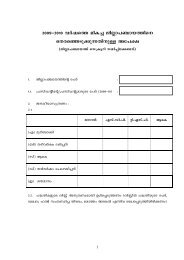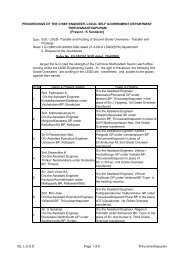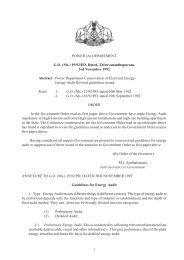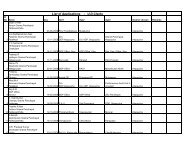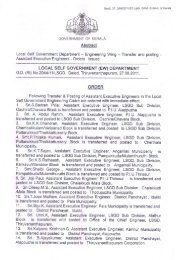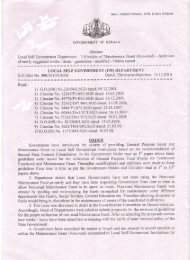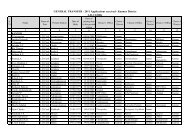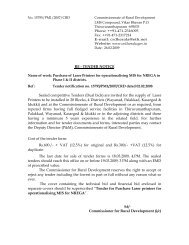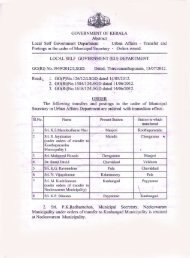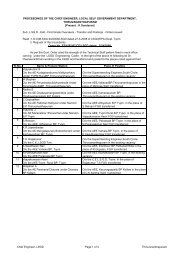Chapter 2 - Kerala Govt Logo
Chapter 2 - Kerala Govt Logo
Chapter 2 - Kerala Govt Logo
- No tags were found...
Create successful ePaper yourself
Turn your PDF publications into a flip-book with our unique Google optimized e-Paper software.
Environmental Assessment Report<strong>Kerala</strong> Local Government Strengthening ProjectThe conservation efforts therefore have to take into account sustainable use which implies,understanding the capacity and restricting the pressures within that. The role of the localgovernments in wetland management basically rests on this premise. The ongoing programmeson wetland include:Centrally sponsored schemes on management of wetlands based on the management actionplans submitted to MoEF by KSCSTE (Sasthankota, Astamudi, Kottuli)State plan programme on ecorestoration of Sasthamkotta wetland- Sanitation programmein the catchments through Suchitwa MissionA management action plan for Vellayani wetlands through the KSCSTEMoEF is considering bringing in a statute for regulating the management of wetlands in thecountry under the Environment (Protection) Act 1986, which will envisage categorization ofwetlands based on a few criteria, mostly related to location and conservation values; acentralized mechanism for management planning for their conservation and regulation ofactivities according to ecological importance. The authorized agencies will be created atnational, state and district levels. However, for implementation of the management actionplans and integration of these into general development planning, the role of LSGs will becritical.Water management and land management are the constitutional mandates of the local selfgovernments. <strong>Kerala</strong> Panchayat Raj Act 1994 specifically provides for environment,sewerage/sanitation and the local water resource management functions with the local selfgovernments. The eleventh schedule under article 243 G of the Constitution provides forentrusting the mandate of maintenance of community assets with these institutions.Customary village common lands and properties also are vested for management andadministration with the Panchayats.Wetlands are the local water resources, intricately connected with not only the life processes,but also several potentially important enterprise functions at the local level. These mayinclude coconut fibre processing, fishing aquaculture and other water based cottage industries,tourism and related activities and overall hydrological regimes which influence the primaryproduction such as the agricultural regimes. Conservation of wetlands enhances the groundwater recharge measures that facilitate supply of potable water for the nearby populations ifmanaged sustainably. In such circumstances, the most critical role of local governments wouldinclude creating an enabling environment for any effort which contributes to the sustainabilityof these resources, and regulating any activity which impinges on the wetland environment.Thus the local governance and development planning in the area of influence for the wetlandenvironment should take into account need of sustaining efforts to keep these ecosystems inbest of natural state.All the global conservation conventions and national policies favour local participation inassessment, planning and management of common property resources. LSGs will have acritical role in according due recognition to the community level organizations by integratingtheir activities in the grass root level plans and providing funds accordingly. The programmes78




